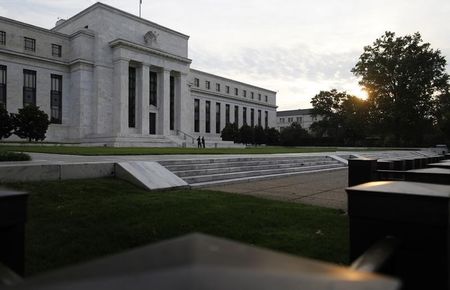By Ann Saphir and Michael Flaherty (Reuters) - The U.S. Federal Reserve is facing perhaps its most pivotal meeting of the year next week, as it debates a potential overhaul of its guidance on interest rates and seeks to nail down a plan for exiting its extraordinarily easy monetary policy.
It remains to be seen whether decisions will be taken on either, but it is clear that details on a so-called exit plan are nearly complete, while discomfort is growing internally over a pledge to keep rates near zero for a "considerable time."
Investors will parse the central bank's words closely for any clues on the timing of the first U.S. rate hike in more than eight years. Any major tweaks to its policy statement could cause ructions in financial markets as investors recalibrate bets on benchmark rates in the world's biggest economy.
A strong run of U.S. economic data has led Fed Chair Janet Yellen and other top officials to acknowledge the possibility they may need to raise rates sooner than they thought just a few months ago, although a surprisingly soft reading on jobs growth in August could provide some breathing room.
"The discussion itself is a testament to the underlying shift in monetary policy," said TD Securities analyst Gennadiy Goldberg. He said ditching the "considerable time" phrase would open the door to a rate hike as soon as March, several months earlier than most investors currently expect.
The Fed has kept overnight rates near zero since December 2008 and has more than quadrupled its balance sheet through a series of bond-buying programs designed to push down borrowing costs and boost investment and hiring.
Fed policymakers have said they do not expect to raise rates until 2015, and their meeting next Tuesday and Wednesday looks certain to end with no change in policy beyond a well-telegraphed reduction in the central bank's asset purchases.
But officials will release fresh economic and interest-rate projections, extending their forecast horizon through 2017. Those, coupled with even minute changes in the Fed's post-meeting statement, could reshape expectations for how soon and how fast the central bank is likely to raise rates.
GROWING STALE
Fed officials from both ends of the policy spectrum have stepped up calls recently to change what Cleveland Fed President Loretta Mester termed the "stale" language on the likely timing of the first rate hike.
The Fed has said since March it expected a "considerable time" to elapse between the end of its bond buying, which is now slated for October, and its first rate hike. "I believe it is again time for the (Fed) to reformulate its forward guidance," Mester said last week.
A few hours after Mester's remarks, Boston Fed President Eric Rosengren, a stalwart backer of the central bank's aggressive monetary policy easing, also called for ditching the calendar-related guidance, while Philadelphia Fed President Charles Plosser, who dissented against the language at the central bank's last policy session in late July, reiterated his concerns on Saturday.
Top economists at a number of Wall Street firms, including Michael Feroli at JPMorgan, Paul Ashworth of Capital Economics and Lewis Alexander at Nomura, now see at least even odds that the Fed will drop the "considerable time" phrase.
It could simply note that it can be "patient" in determining when to raise rates or could emphasize, as Yellen did with a speech in August, that the timing of a rate hike could move forward if economic data comes in stronger than expected.
The guidance is only one of the tricky questions facing the Fed. Officials also need to finalize details on how they plan to move rates higher and keep inflation from igniting, given the extraordinary liquidity sloshing around the financial system from their purchases of government and housing-related debt.
Minutes from their July meeting show officials now generally agree on several important changes to a set of exit principles first published in 2011, including steps to prevent the Fed's balance sheet from shrinking before rates rise. Most of them also now think the Fed should hold on to most of the housing-backed securities it has purchased.
Still under intensive discussion is how to use a newfangled tool developed by the central bank's New York branch to help sop up excess liquidity when the Fed starts tightening policy.
Minutes of the last meeting show it is increasingly likely the Fed will relegate the new overnight reverse repurchase facility to a supplementary and maybe temporary role, in part due to worries it could spark "runs" from more risky markets in times of financial stress.

Agreement on that matter could pave the way for public release of an exit blueprint as soon as next week.
(Reporting by Ann Saphir in San Francisco and Michael Flaherty in Washington; Editing by Tim Ahmann and Paul Simao)
